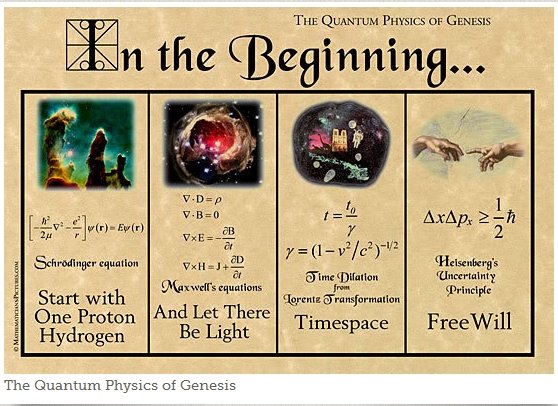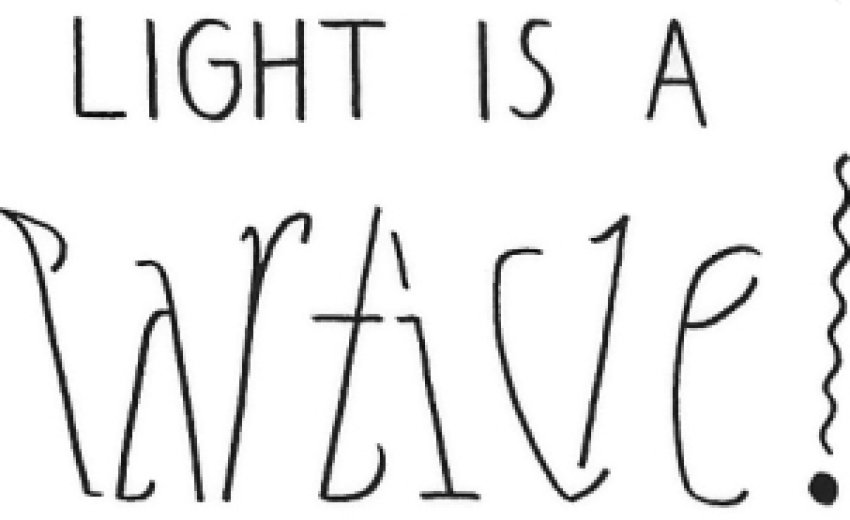The Wave-Particle Duality as described in Sri Guru Granth Sahib
 Introduction
Introduction
Wave-particle duality theory postulates that all particles exhibit both wave and particle properties. This is a fundamental concept of quantum mechanics. Standard interpretations of quantum mechanics explain this paradox as a fundamental property of the Universe, while alternative interpretations explain the duality as an emergent, second-order consequence of various limitations of the observer. Sri Guru Granth Sahib had already held the theory of wave-particle duality in 15th and 16th century and as recorded in the hymns of Guru Nanak, Guru AmarDass, Guru RamDass and Guru Arjan. The development of this theory in science and the theory already explained in Sri Guru Granth Sahib are discussed here.
Adi Guru Granth Sahib (AGGS), the sacred scripture of Sikhs, contains hymns of Sikh Gurus and Hindu and Muslim saints in 1430 pages. Compiled in 1604 by Guru Arjan and penned by BhaiGurdas, it consists of hymns of devotion to God, inspired reflections on the cosmic order, the vision of the higher life and exhortation to man towards lifting himself to the state of spiritual peace and the attainment of liberation. The universal doctrines of Sri Guru Granth Sahib are based on truth, compassion and justice and provide light to the spiritual as well as scientist community specially regarding origin and development of universe i.e., cosmology. Sri Guru Granth Sahib has recorded details of dark energy and dark matter specifically in the hymns of Guru Nanak and also in the hymns of Guru Amar Dass, Guru Arjan, other Gurus and saints in some form. Many other scientific explanations being explored now like the origin, creation, matter, biological characteristics, have been outlined in Sri Guru Granth Sahib already. In this paper the principle of wave-particle duality is discussed. These details recorded more than 500 years ago are proving emphatic and can provide guiding light for the scientist that are unable to go beyond big bang.
Relationship of Science and Religion
A scientist deals with this visible Creation and the visible form of energy i.e., in the field of aparavidya. A scientist infers, investigates and draws exact conclusions from his observations of the only small part which he can observe. God's Nature is limitless and he works within limits. He understands Nature but he knows nothing of the origin or destiny of Nature. Scientist researches into this area but has succeeded into an iota of it; as this visible energy too is too much for him to observe.
We know that energy is in continuity. Everything formed out of energy is connected. Energy is said to be a continuity of God too. In spiritual technology atma and parmatmaare said to be connected and in continuity. As said earlier God is everywhere and in everything. As one cannot see, feel, hear or touch the God directly, one can do so through His Creation; His nature. To understand Him one has to understand His Creation. Every being is His Creation. You, me and all and everything else is His Creation. Knowing every bit or any bit of His creation can provide one His knowledge. Why to go far then. You can start understanding yourself and you will understand Him. You are made of physical and the subtle. Physical consists of your physical structure. The inner consists of your energy, your mind and your soul.
The soul is said to be in continuity with the God. Atma though contained in body is part of the limitless, the Parmatma, the God. God is limitless and to know the limitless you can find the boundaries within yourself. If one knows its part; the soul, one can understand the limitless the God. This revelation comes from within. That is how the great men like Buddha, Mahaveer, Christ, Mohammad or Nanak who had obtained the knowledge of the God and His Universe.
The mind of such great men is subtle and pure. It is free from worldly desires and passions, from selfishness, lust and hatred. It is filled with purity. It is free from outgoing tendencies. It is fit for divine contemplation. It is properly disciplined in a variety of ways through rigorous austerity and self-restraint. They detach their minds from outer attachments and undergo a discipline, a rare discipline-through the practice of tranquility of mind, control of the senses, restraints, internal and external purification, etc., which is not yet being given in the universities.These great men go directly to the cause or the source. They dive deep into the source and bring forth the pearl of knowledge of the Self. The man of science sees and observes things only as they appear to be to his sense-perception. The seers perceive them as they actually are in their very essential nature. They have direct intuition and perception of the Truth through super conscious state) and come to the effect-the manifested universe. Therefore, their utterances are infallible. They are gospel truths. These are direct revelations. They are the infallible utterances of the seers or sages. They are beyond questioning, beyond the least shadow of doubt.
This is how the completely unified knowledge is achieved. These saints and seers get inner, divine realisation. They clearly see with their inner eye the subtle rudiments of matter. They identify themselves with the Supreme Being, the Lord of the nature; the matter. They get control over the five elements. They clearly understand the whole mystery of creation through direct intuitional knowledge.
All secular sciences have their own limitations. A scientist works on the physical plane with a finite mind and with instruments. He knows the physical laws. He has some knowledge of the elements, atoms and physical energy. His knowledge is fragmentary. He has no experience of the whole. He has no knowledge of transcendental or super-sensual things.
The religion and science have been differing in many aspects like the point and time of origin or universe, matter and life, the sequence of formation of universe, matter and life; likely end of these three and many such like answers. But these do not differ that there was dark before the light emerged; that the energy as the fundamental source that there was a single point of origin; that the energy is both subtle and solid; wave and particle; that it is continuously changing; that shapes are the result of the change; that no two shapes are the same; that these shapes are not the same the very next moment and keep on changing forms continuously; that these shapes have rapid changes in the form of death and birth and such like answers.
According to the modern science the beginning is in a Big Bang. It is taken to be finite in both space and time i.e., it had a beginning and will have an end someday. This Universe is said to be homogeneous and isotropic. Homogeneity means that the entities involved are the same in all locations. Isotropy means that the entities are the same in all directions. These terms imply uniformity at some scales - generally large (cosmic). Thus, the Universe would appear much the same at any point within it.
According to Einstein it is the 'fundamental element' and according to Vedas and Upanishads it is the fundamental soul or Parmatma. There is no life and death as imagined by human beings. These are mere changes of beings in different forms or shapes. In reality there is nothing like life and death. God can be called an electrifying force. It is fundamental to all materials. The universe, its development, its activity, all units are activated through its activated energy. All activities are because of this fundamental 'Parmatma'.
Fundamentally these elements are both nirgun (attribute less) and sargun (consisting of all attributes). He has no worldly attributes but all the attributes of the universe originate from Him. God is both visible and invisible. God is attribute less while considered to be having attributes too. His attributes can be seen in His creation; His nature. He spreads from the base which remains in peaceful attribute less condition in each atom of the universe. He can be seen through His Creation as He is considered to be in every part of His creation, both at Macro and Micro level; from Nebulae to photon level. It is like the sea spread peacefully while various waves keep on originating from it. The universe is also like a wave originated from the sea. The only difference is that it is the fundamental power circuit of life form with neutrons as the base while protons and electrons spread around causing countless power circuits. The waves too are power circuits but these originate from the sea which itself is a power circuit of the fundamental energy. While the fundamental power circuit remains stable, the temporary circuits of waves keep on changing, coming out of sea and merge in it again. This fundamental circuit is permanent; it neither emerges nor vanishes. This is why it is called Saibhang (self-originated).
The energies initially concentrated at a point, known as zero point, Shunyaor Sunn, which is light in density or is just a vacuum. The energies around it are attracted to this zero point, as we find a cyclone rushing to a vacuum point. Once the energy gets contracted at this zero point, the pressure develops outwards. A circuit is caused whereby the energy is attracted and distracted like a sea-saw.
Development of the Wave-Particle Duality theory in Science
Ancient philosophers like Aristotle, Democritus. Rene Descartes, Young, Maxwell, Newton, Robert Hook etc., have been considering particles of the universe as mono-atomic. None of them considered the universe particles both as a wave and a particle in diatomic form. The idea of duality became a reality through the works of Max Planck, Albert Einstein, Louis de Broglie, Arthur Crompton, Niels Bohr and many others and the current scientific theory holds that all particles also have a wave nature (and vice versa).1 This phenomenon has been verified not only for elementary particles, but also for compound particles like atoms and even molecules. For macroscopic particles, because of their extremely small wavelengths, wave properties usually cannot be detected. For both large and small wavelengths, both matter and radiation have both particle and wave aspects.... But the wave aspects of their motion become more difficult to observe as their wavelengths become shorter.... For ordinary macroscopic particles the mass is so large that the momentum is always sufficiently large to make the de Broglie wavelength small enough to be beyond the range of experimental detection, and classical mechanics reigns supreme.2
In the formalism of the theory, all the information about a particle is encoded in its wave function, roughly analogous to the amplitude of a wave at each point in space. This function evolves according to a differential equation (generically called the Schrodinger equation). This equation gives rise to wave-like phenomena such as interference and diffraction. The particle-like behavior is most evident due to phenomena associated with measurement in quantum mechanics. Upon measuring the location of the particle, the wave-function will randomly "collapse", or rather "decohere", to a sharply peaked function at some location, with the likelihood of any particular location equal to the squared amplitude of the wave-function there. The measurement will return a well-defined position, (subject to uncertainty), a property traditionally associated with particles. This phenomenon is described as wave-particle duality The wave-particle model is consistent with De Broglie's hypothesis and Heisenberg's uncertainty principle. De Broglie's formula was confirmed three years later for electrons with the observation of electron diffraction in two independent experiments. De Broglie was awarded the Nobel Prize for Physics in 1929 for his hypothesis and Thomson and Davisson shared the Nobel Prize for Physics in 1937 for their experimental work.Afshar's experiment3(2007) has demonstrated that it is possible to simultaneously observe both wave and particle properties of photons.Since the demonstrations of wave-like properties in photons and electrons, similar experiments have been conducted with neutrons and protons. Among the most famous experiments are those of Estermann and Otto Stern 1929.4 Authors of similar recent experiments with atoms and molecules, described below, claim that these larger particles also act like waves. This was an astounding discovery. Just one of the effects of thiswave-particle duality is that photons, though treated as particles, can be calculated to have frequency, wavelength, amplitude, and other properties inherent in wave mechanics. 5
Wave-particle duality is exploited in electron microscopy, where the small wavelengths associated with the electron can be used to view objects much smaller than what is visible using visible light. Similarly, neutron diffraction uses neutrons with a wavelength of about 0.1nanometer (nm), the typical spacing of atoms in a solid, to determine the structure of solids.6

On July 23, 1847 Von Helmholtz in his paper on the conservation of energy set forth the doctrine that the law of conservation of energy was applicable everywhere in living things as well as in inanimate objects. He considered it as a universal law of nature and a new guiding principle in the study of natural science.7 Nineteenth century Physicists realized that one form of energy can be transformed into another.8
In the twentieth century, man of science came to realize that energy can be transformed into mass and mass into energy. In the special theory of relativity Einstein worked out the relation for the transformation. It has played on all important part in the development of atomic energy for war and peace.9Energy can neither be created nor can be destroyed. The sum total of energy always remains the same in the universe.10 Keeping these fundamental principles of wave-particle duality, conservation of energy and the continuous change in the forms of energy, this paper explores the relative importance of already existing facts in Sri Guru Granth Sahib.Sri Guru Granth Sahib and Wave Particle Duality Theory The scientists were able to have vague idea of wave-particle duality in 17the century but were able to experiment in 20th century. Guru Arjan however described in 16th century that all the particles are in the wave forms.11Referring to the creation of the universe, he said:
"Whatever is subtle in waves is also solid in particles."12
ਨਾਨਕਸੋਸੂਖਮੁਸੋਈਅਸਥੂਲੁ॥੫॥(ਮਃ 5, ਪੰਨਾ 281, ਸਤਰ 18)
In the unmanifest, he sees the manifest world to exist.
ਸੂਖਮਮਹਿਜਾਨੈਅਸਥੂਲੁ॥ਮਃ 5 ਪੰਨਾ 274, ਸਤਰ 15
The entire universe either subtle or solid is the body the God
ਸੂਖਮਅਸਥੂਲਸਗਲਭਗਵਾਨ॥ (ਮਃ 5, ਪੰਨਾ 281, ਸਤਰ 18)
In fact the Gurus described the entire God (and His creation) as both subtle waves and particle solid.
ਆਪਹਿਸੂਖਮਆਪਹਿਅਸਥੂਲ॥੮॥ਪੰਨਾ 1236, ਸਤਰ 8
ਆਪਹਿਸੂਖਮਆਪਹਿਅਸਥੂਲਾ॥ਮਃ 5, ਪੰਨਾ 250, ਸਤਰ 10
God have created the universe out of light where he was first in wave form (subtle) and
later turned into the particle (solid) form.13 He became manifest from unmanifest.
ਤੂੰਸੂਖਮੁਹੋਆਅਸਥੂਲੀ॥ਮਃ 5, ਪੰਨਾ 102, ਸਤਰ 15
He changed the wave quality of energy
The God is in subtle form having a solid form of bodies
ਸੂਖਮਮੂਰਤਿਨਾਮੁਨਿਰੰਜਨਕਾਇਆਕਾਆਕਾਰੁ॥ ਮਃ 1, ਪੰਨਾ 466, ਸਤਰ 1From the very small and subtle He expanded the entire universe.
ਆਪੇਸੂਖਮਭਾਲੀਐਆਪੇਪਾਸਾਰੁ॥ ਮਃ 4, ਪੰਨਾ 556, ਸਤਰ 17
O Nanak, He is the subtle, and He is also the manifest.
ਨਾਨਕਸੋਸੂਖਮਸੋਈਅਸਥੂਲੁ॥੫॥ਮਃ 5 ਪੰਨਾ 281, ਸਤਰ 18
The Lord God is in all mind and matter, subtle and manifest.
ਸੂਖਮਅਸਥੂਲਸਗਲਭਗਵਾਨ॥ਮਃ 5 ਪੰਨਾ 281, ਸਤਰ 18
The Dear Lord is subtle and inaccessible; how can we ever meet Him?
ਹਰਿਜੀਸੂਖਮਅਗਮੁਹੈਕਿਤੁਬਿਧਿਮਿਲਿਆਜਾਇ॥ਮਃ 3, ਪੰਨਾ 756, ਸਤਰ 18
He is all-pervading, permeating all places; He is in subtle essence and manifest form. ||1||
ਰਵਿਰਹਿਆਸਰਬਤਠਾਈਸੂਖਮਅਸਥੂਲ॥੧॥ਮਃ 5, ਪੰਨਾ 987, ਸਤਰ 19
All beings, both subtle and gross, meditate in remembrance.
ਸਿਮਰਹਿਥੂਲਸੂਖਮਸਭਿਜੰਤਾ॥ਮਃ 5, ਪੰਨਾ 1079, ਸਤਰ 5
From the very small and subtle, You have become huge and manifest.
ਤੂੰਸੂਖmuਹੋਆਅਸਥੂਲੀ॥ਮਃ 5, ਪੰਨਾ 102, ਸਤਰ 15
Biblio:
1Walter Greiner (2001). Quantum Mechanics: An Introduction. Springer.ISBN 3540674586
2R. Eisberg and R. Resnick (1985). Quantum Physics of Atoms, Molecules, Solids, Nuclei, and Particles (2nd ed.).John Wiley & Sons. pp. 59-60. ISBN 047187373X.
3Afshar S.S. et al: Paradox in Wave Particle Duality. Found. Phys. 37, 295 (2007) http://arxiv.org/abs/quant-ph/0702188arXiv:quant-ph/0702188
4Estermann, I.; Stern O. (1930). "Beugung von Molekularstrahlen". ZeitschriftfürPhysik61 (1-2): 95-125.? Bibcode1930ZPhy...61...95E. doi:10.1007/BF01340293.
5http://physics.about.com/od/lightoptics/f/photon.htm
6Donald H Menzel, "Fundamental formulas of Physics", volume 1, page 153; Gives the de Broglie wavelengths for composite particles such as protons and neutrons.
7 The Book of Popular Science, Vol. 6, new York ,p.252
8 Ibid, Vol 6, p. 252
9 Ibid, p.217
10 Ibid p.216
11Sookhammah(i) janaiasthool (u) (SGGS, M 5, p. 274, line 15)
12 Nanak so sookham(u) soiasthool(u) (SGGS, M.5, p. 281, line 17)
13Toonsookham(u) hoaasthoolee. (SGGS, M.5, p. 102, line 15)






